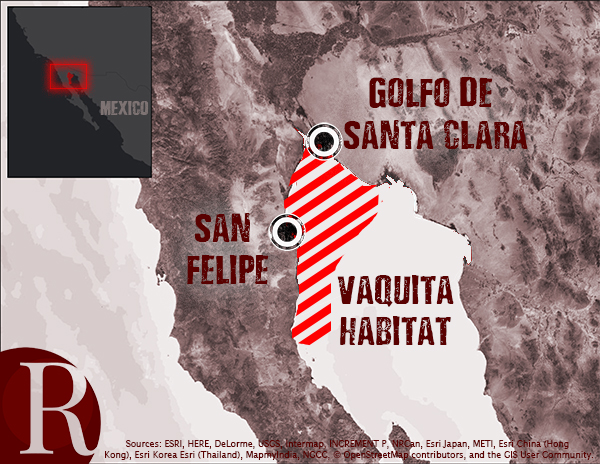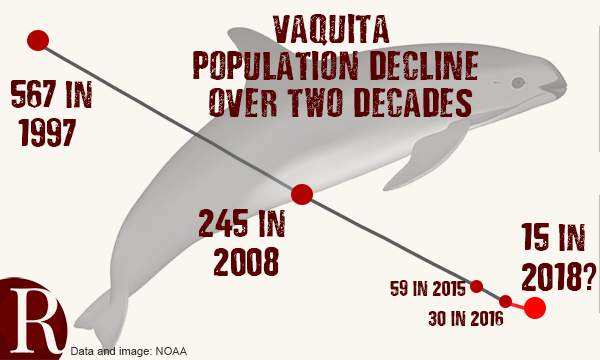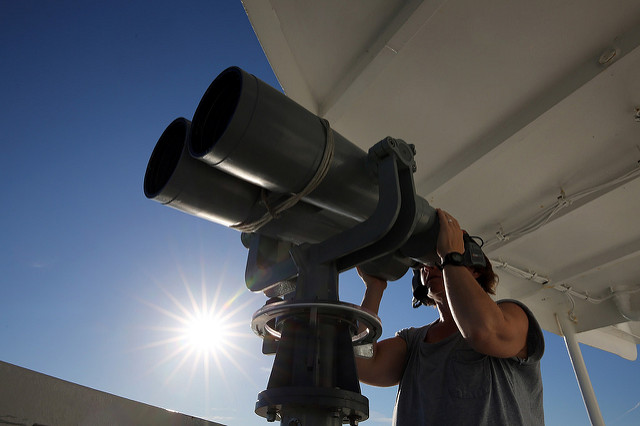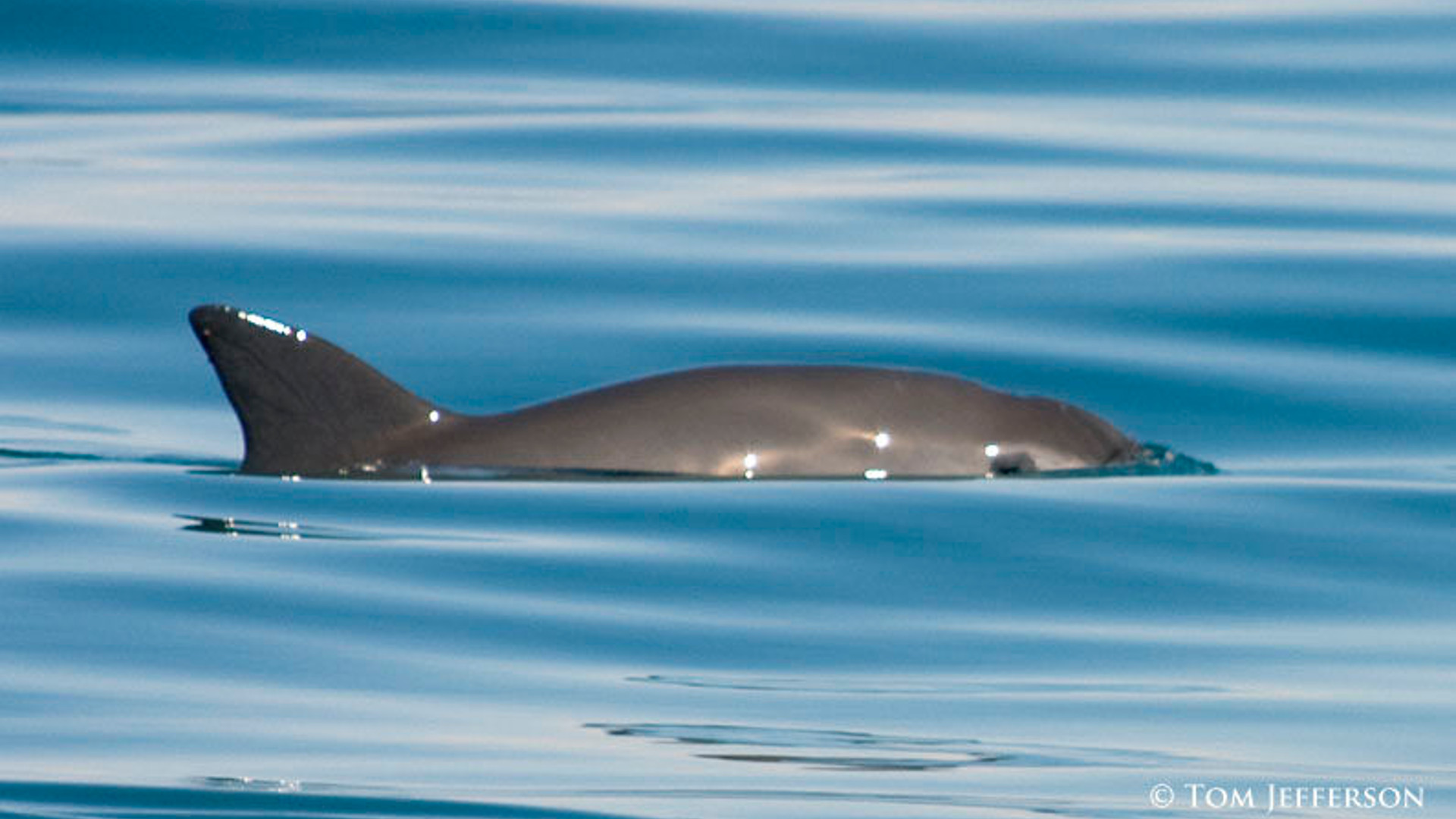The race to save the vaquita porpoise (Phocoena sinus) from extinction has begun.
Earlier this week the Mexican government announced a permanent ban on the use of gillnets within the Gulf of California — a step that has become necessary to save the critically endangered vaquita. Fewer than 30 of these rare cetaceans remain in the northern Gulf, the species’ only habitat, where their population has been utterly devastated over the past few years by illegal fishing nets.

The massive gillnets aren’t actually used to target vaquitas. Poachers are looking for a fish called the totoaba (Totoaba macdonaldi). Totoaba swim bladders, long considered a treatment for circulatory and skin problems in traditional Chinese medicine, have soared in value in recent years, selling for upwards of $4,500 a pound. That price is hard to ignore in an impoverished region.
Conservationists have called for a permanent gillnet ban for years. It finally came to pass after actor Leonardo DiCaprio put public pressure on Mexican President Enrique Peña Nieto, who, with DiCaprio and billionaire Carlos Slim, signed a memorandum of understanding last month to strengthen the country’s fishing legislation. That set the stage for this week’s gillnet ban.
Still, experts fear the ban won’t be enough. Conservationists also have a controversial, and admittedly last-ditch, plan to try to bring some vaquitas into captivity, putting them in the equivalent of protective custody. They’ll use a fleet of boats and a team of U.S. Navy dolphins to round up as many of the small porpoises as they can find, then move them to special enclosures that are being built now.
To understand how we got to this point, and what comes next, I spoke with biologist Barbara Taylor from the National Marine Fisheries Service and the Consortium for Vaquita Conservation, Protection, and Recovery (VaquitaCPR). A lightly edited transcript of our conversation follows.
John Platt: The last time we spoke, the vaquita population had fallen to about 100, then it was 60. Last year we heard that the number had fallen even further, to just 30. How many are there now?
Barb Taylor: Well, the truth is, is that we won’t know the new abundance number until September. The next acoustic monitoring will finish in the middle of August, and we hope to have a new number out the first week of September. I’m anticipating that it will be a rate of decline like we’ve been seeing. We went from 60 to 30 and we’ll probably lose another half by the end of this year, I would guess.
So yeah, it’s very grim.

Platt: It must weigh heavily on the whole team of people working on this species.
Taylor: Oh, yes. We’re definitely in emergency mode. It’s been quite the rollercoaster, I have to say, just getting results back and seeing dead vaquitas.
We had a temporary ban in place and vaquitas still continued to decline, which is why we are pushing forward. We need to get them out — capture as many vaquitas as we can as quickly as we can until we have evidence that the gillnets are out of the water.
Platt: So why do you think the previous, temporary gillnet bans weren’t enough or didn’t work? I’ve seen a lot of comments about funding to fishermen being distributed unequally, and obviously there’s a level of corruption going on. What were the barriers to success there?
Taylor: Well, I think there were a number of barriers, the biggest one being that totoaba is still incredibly lucrative and nobody has gone to jail over that. And the penalties, even if you do get caught, are minor. It’s just a cost of business. So, it’s such an enormous temptation to go totoaba fishing. That made it very difficult.
And then, enforcement has not done what needs to be done. The evidence is Sea Shepherd pulling out over 250 nets totoaba nets and other gillnets in the last two years. So clearly the fishermen are operating outside the law.
And I’m sure there’s some blame to go around on the compensation front, but that’s never really been well documented except, ironically, with some of the fishermen who were really the good guys, the guys who tried to convert to alternative gear and yet were not compensated. So yeah, that’s the biggest thing.
The second thing is that there was a loophole in the ban that allowed corvina (Cynoscion othonopterus) fishing. Corvina is the smaller cousin of totoaba and the big capture period is when they are aggregated for spawning right at Easter, which is when lots of Catholics like to eat fish, so it has been one of the major fisheries in the area. It’s an active gillnet fishery so they wrap the corvinas in this rodeo-style method.
It’s not been known to kill vaquitas and so they exempted it, but by doing that there were, I think, a couple of really bad outcomes. One, everybody had gillnets all the time, so the number of gillnets has not really decreased.
The other is the operation for totoaba. What they do is set one of these nets on the bottom with huge anchors and no surface markings. They just go down, hook the net, pull it up, taking the totoaba out and letting it drop back down to the bottom.
Well, it doesn’t really take that long to do that and it’s a relatively big area. So any boat that’s out in the water doing anything, they could be doing corbina fishing, but they could be looking like they’re sports fishing or whatever. The minute that no one’s looking they go over to their totoaba net and they pull the totoabas. So I think having all of the boats on the water for corbina season, which is the same time the same spawning season as totoaba and corbina, that’s when we saw all the dead vaquitas. And there were hundreds of boats out in the water, which just makes enforcement a nightmare.
Platt: Is fishing the main economic opportunity for the people in that region?
Taylor: Definitely for El Golfo de Santa Clara. It’s basically that and purported illegal activities of moving drugs through the area and human trafficking and things like that.
San Felipe has the big Baja 250 road race and it has a tourism industry built up around that. But since 2008, when the economy went sour and the drug wars happened at the same time, the tourism has really dropped off. Just when the fishermen actually were starting to convert to different kinds of gear and livelihoods, the hotels, restaurants and economy went south and just sort of drove them back into the dependency on fishing. It is still, I think, the spine of both of those communities, but it’s everything or nearly everything in El Golfo.
Platt: So now there’s the gillnet ban, the Mexican president and Leonardo DiCaprio and the Slim Foundation, plus the effort to get some of these animals into captivity. Are these three all kind of working in conjunction with each other?
Taylor: We hope so. That’s the intention. We always are concerned that something will happen like with California condors, that there will be a major NGO pushback on the idea of taking vaquitas into captivity. So far that hasn’t happened, even though many NGOs won’t actively endorse that strategy. But the recovery team basically acknowledged that Plan A of recovering vaquitas was making their habitat safe and gillnet free. There’s no evidence that that’s working and now we’re down to maybe 15 individuals left.
Despite all of the uncertainties with capturing vaquitas and keeping them in captivity, it’s still in my mind safer than it is leaving them out where they have a 50 percent chance of dying in a gillnet.
Until there’s real evidence that not only are the laws in place, but they’re being effectively enforced and there really aren’t gillnets in the water, you have to move forward on trying to keep some animals safe. Otherwise we’re going to lose them in the next year or two. I mean that’s just the reality.
The other reality is that unlike California condors, once you make the decision, we can’t pull them all out of the wild overnight. There’s lots of uncertainty.
And so we’re pushing forward as hard as we can on both fronts, because even if we are successful in catching some vaquitas in October and November we’re not going to have any chance at catching all the vaquitas. Some will be out there in that dangerous habitat no matter how successful we are.
And it may be that they aren’t suitable for captivity. We won’t know that until we try. In fact, we won’t know whether we can even catch them. We’re going out there with this tremendous team of experts from all over the world to try to make this happen and I can’t imagine a better team of people. We’re giving it the best shot we can, but it’s still uncertain that we’ll even be able to catch one.
Platt: It’s a huge habitat isn’t it? I mean it’s like looking for a needle in a haystack.
Taylor: Yes, that’s my job. I am the looker for the needle in the haystack.
That happens to be my piece in this now-very complex puzzle. We’ll use the experience that we’ve developed doing surveys for vaquitas to get the same team of experts out there and use our big binoculars to try to find them. And what we found in 2015 was that the animals had hugely contracted their distribution. So, there wasn’t as much area to really survey. Plus we have our acoustic monitoring grid that’s out there as we speak and it will be getting us 3,000 days of data in the next couple of months about where the vaquitas are spending their time.

So we have a lot more insight as to where to look for them. It’s not as big an area as one would think. I mean basically they’re spending all their time on one of three little ridges. They’ve sort of contracted back to their absolute best spots, so I think if they’re out there we can find them. But then keeping track of them is also something that has been extremely difficult in the past. In the past we were using one ship with six pairs of these giant 25-power binoculars, but you can only really look in one direction. When vaquitas are broadside you can see that triangular dorsal fin side and even then it’s hard to see them. If they decide that they don’t like the vessel noise and they’re going to move away from you, then you just get this knife’s edge view.
We’re actually going to use three visual platforms so that we can sort of form a triangle and reduce the chance of losing them. That’s where the Navy dolphins come in to actually help track the animals, so that we can get the experts with their nets in the right place at the right time and hopefully catch them and be able to then evaluate how they respond to being handled.
There are many steps along the path.
Platt: So, you would theoretically capture one, and if it doesn’t pass the first test it would go back in the water?
Taylor: Right. Each one of the catch vessels will have a porpoise veterinarian onboard and they are trained to recognize the symptoms of an animal that’s going into shock. And if it does start to go into shock then the plan is to release them, but with a satellite tag on them.
If we have any bad outcomes we have an independent panel of expert veterinarians that will help us evaluate what the next step will be, whether we should try again or whether we should declare them to be just not suitable for captivity, like Dall’s porpoise.
Platt: On the off chance that they are suitable, you’re building a containment center for them right now. Is that in the ocean or on land next to the water?
Taylor: Yes, both. The plan is to build these tuna pens — if you’ve been down to Ensenada you’ll see them floating off the coast there — that are specially designed for the porpoises. They can actually be anchored out where the animals are spending all their time now. So, it’ll be sort of a soft introduction. We’ll be able to evaluate them, put them in these ponds right out in their habitat that they’re used to, evaluate how they’re doing, teach them how to eat dead fish, all of that in the first month. Meanwhile, there’s a facility that’s being built as we speak that is basically a vaquita temporary hospital on land. It will have pools where if an animal got sick or needed to be separated for some reason and have intensive care they could be moved into those pools or in case of an emergency, if there’s a red tide or there’s a hurricane.
And then, as winter approaches the idea is to construct sea pens that are accessible from land behind the protective mountains. In winter storms it’s very difficult to get out and feed them. It’s just much better to be able to walk out a walkway and be able to take care of the animals, but still have them in their natural environment that they’re used to with the temperature and water turbidity and all those kinds of things. So, that is all designed, but isn’t being built yet, and the other two are actually in construction.
Platt: I remember you telling me a couple of years ago that these are very slow-breeding animals. They take a while to reach sexual maturity and only reproduce once every couple of years. So even if we manage to stop the attrition and get these animals breeding, it’s still going to take a while to rebuild the population. Do you have any confidence or hope in the ability to grow the population again?
Taylor: I have become a student of species that have gone extinct in the wild, or have gone through a captive phase, then recovered and been reintroduced and have now healthy populations in the wild again. There are many amazing examples of animals that have gone down to way lower numbers. In fact a New Zealand robin went down to two and the California condors down to eight. But they are birds, so it makes it a little easier because you can get several offspring every year.
But there are examples of mammals that only have one offspring per year that were in similar situations. Przewalski’s horses and Père David’s deer were both less than 15 when they were taken into captivity. And yeah, it took decades. We have to be realistic about that. If we can’t release them back into the wild, we’re in this for the long haul. It would be completely unprecedented with a marine mammal, so it’s a big challenge for sure and we can only hope that they actually can have one offspring per year instead of one every other year. But we won’t know until we try.
Platt: International Save the Vaquita Day is coming up on July 8th. What would you like my readers to know that could help these efforts?
Taylor: Well, right now I think the most important thing people can do is to donate to Vaquita CPR, where we’re still a half-million dollars short on a $5 million budget. Everyone can play a role now that we’re down to needing to pay for the emergency room.
The other really important thing — and I say this as somebody who works on many species globally — is that people learn more about gillnets, which are the biggest threat to marine mammals and to too much marine life.
Everybody, when they go out to restaurants, they’re eating seafood that’s been caught in gillnets, and I think people are just unaware that hundreds of thousands of animals inadvertently die in those nets every year. Pushing on Mexico to make this the first good example of converting a community over to using gear that isn’t driving species extinct is really important. Because there are many other species, sadly, that will be lined up behind vaquita if we lose them. They’re going to blink out because of gillnets. And I think people are just completely unaware of what astounding effect this is having on marine life.
The Revelator will bring you updates on the efforts to save the vaquita throughout the year.



As long as there are at least a male and a female vaquita left, there’s a chance. But with a population this low it will probably take a captive breeding program to raise the species’ numbers high enough to become self-sustaining.
Like all governments, the Mexican government prioritized economics over the environment, which in this case means vaquitas and totobas. Governments do this because that’s what most people want. The failure here is the failure of the human race, not just of the Mexican government.
Also, gill nets are a very ecologically destructive method of fishing and should be banned everywhere. Using gill nets is not only overfishing, but that use also kills many unintended fish and marine mammals. Hand-held poles on reasonably-sized ships is the only environmentally friendly way to fish.